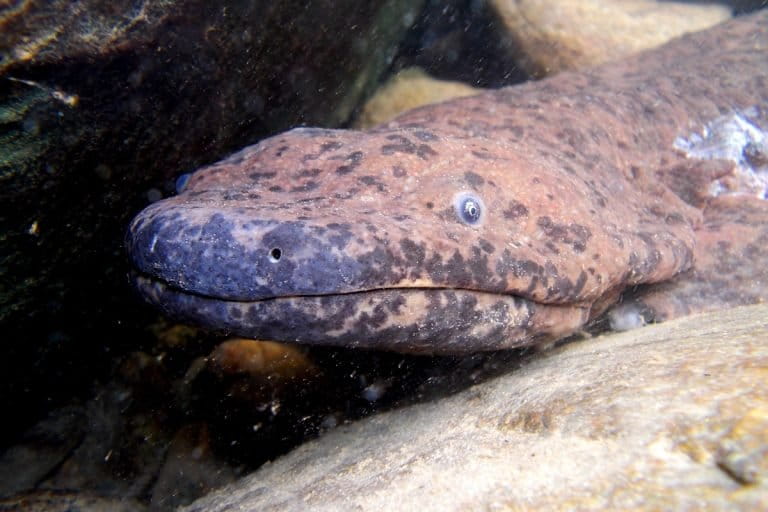- Scientists who spent four years surveying the Chinese giant salamander’s preferred river habitats across 97 counties in China spotted only 24 individuals at four sites.
- None of the 24 individuals were “pure natural forms,” the researchers found, and were likely farm releases or escapees.
- The Chinese giant salamander also represents not one but at least five different species-level lineages. However, the large extent of hybridization in these animals through farming could mean that these distinct lineages are already functionally extinct.
The world’s largest amphibian has become vanishingly rare in the wild, a new study has found.
The Chinese giant salamander (Andrias davidianus) can reach lengths of more than 1.8 meters (6 feet), taller than many humans, making them hard to miss. Yet scientists who spent four years surveying the salamander’s preferred river habitats across 97 counties in China spotted only 24 individuals at four sites. In all, it took them 16 weeks on an average to detect one salamander, the team of Chinese and Western researchers report in a new study published in Current Biology.
Compare this with the time it took researchers to spot the two other giant salamander species in past surveys: a little more than an hour to spot one Japanese giant salamander (Andrias japonicus) in Japan, and a little over two hours to spot an individual hellbender (Cryptobranchus alleganiensis) in the eastern U.S.
The dearth of detections despite such an extensive survey suggests that the once-widespread Chinese giant salamander has now vanished from much of its range, the researchers say. The species’ slide toward extinction is largely because the creatures are illegally collected from the wild for farming as a luxury food item. Millions of Chinese giant salamanders are being farmed today. And most breeding individuals in these farms have either been caught from the wild, or are first-generation offspring of wild-caught salamanders.
“The overexploitation of these incredible animals for human consumption has had a catastrophic effect on their numbers in the wild over an amazingly short time span,” Samuel Turvey, lead author of the study and a research fellow at the Zoological Society of London, U.K., said in a statement.

However, the extremely low number of individuals in the wild is not the only worry the researchers have.
None of the 24 Chinese giant salamanders that the team found may be “truly” wild, the researchers say. Instead, they are likely farmed individuals that either escaped or were released into the wild as part of government-promoted conservation initiatives to protect the salamander, currently listed as critically endangered on the IUCN Red List.
In a second study, also published in Current Biology, researchers found that the Chinese giant salamander represents not one, but at least five different species-level lineages. Robert Murphy, a professor at the University of Toronto, Canada, who had previously suspected that the salamander could be a “composite of more than one cryptic species,” teamed up with researchers from China and elsewhere to collect tissue samples from 70 wild-caught and 1,034 farm-bred salamanders. Genetic analysis of the wild-caught individuals confirmed that the Chinese giant salamander once consisted of at least five distinct lineages, each associated with a different river system. But genetic analysis of the farmed salamanders showed extensive genetic mixing among the individuals.
This is worrying, the conservationists say.
“The real shock came when we discovered the extent of genetic mixing that occurred via hybridizing the species during farming,” Murphy told Mongabay. “We were also surprised at discovering that many of these hybrids had been released in nature.”
None of the 24 individuals that the researchers detected over the four-year survey were “pure natural forms,” said Jing Che, from the Kunming Institute of Zoology, Chinese Academy of Sciences. “This means that current conservation initiatives are driving genetic pollution in nature. This could be a huge problem,” she said.
Hybridization is a problem because it results in the creation of new genetic products such as essential proteins and enzymes, and too much genetic variation can be quite harmful, Murphy said. “This is what the farms have done,” he added. “By analogy, if you send one person to change a light bulb, the task is usually quick and simple. However, if you send 10 people, and all must participate, things slow down to a snail’s pace and nothing works well.”

The extent of hybridization among the Chinese giant salamanders could also mean that the distinct wild lineages are either already functionally extinct, or nearly there, the researchers say.
“Most conservation laws are based on species,” Che said. “When you divide one species into many, each has a smaller distribution than before and lower numbers of individuals. What might be endangered in the former case, now becomes critically endangered with extinction in the latter situation. Unfortunately, extinction may have occurred already.”
The release of farmed salamanders into rivers may be well-intentioned, the researchers say, but it’s being done without any prior genetic testing or disease screening.
This is partly because the conservation managers responsible are either “unaware of the genetic consequences of hybridization, or summarily dismiss expressed concerns,” Murphy said. “In a zeal to gain public and government favour, the conservationists have created a genetic mess. The same holds true for not screening for disease. Efforts to restock the giant salamanders could be harming other native species via infections.”
Murphy cautioned that no good could come from these “uninformed releases.”
“These activities should stop immediately,” he said. “The hope is that genetic screening can identify pure individuals which can then be used in government-run farms whose only purpose is to recover natural populations, and by using genetic and disease screening before releasing babies.”

Citation:
Turvey, S. T., Chen, S., Tapley, B., Wei, G., Xie, F., Yan, F., … & Okada, S. (2018). Imminent extinction in the wild of the world’s largest amphibian. Current Biology. 28(10):R592-R594.
Yan, F., Lü, J., Zhang, B., Yuan, Z., Zhao, H., Huang, S., … & Chen, S. (2018). The Chinese giant salamander exemplifies the hidden extinction of cryptic species. Current Biology. 28(10):R590-R592.